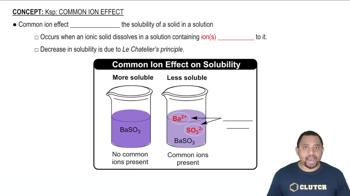Textbook Question
Predict the chemical formulas of the compounds formed by the following pairs of ions: (c) Hg22+ and CO32-

 Verified step by step guidance
Verified step by step guidance



Predict the chemical formulas of the compounds formed by the following pairs of ions: (c) Hg22+ and CO32-
Predict the chemical formulas of the compounds formed by the following pairs of ions: (d) Ca2+ and ClO3-
Predict the chemical formulas of the compounds formed by the following pairs of ions: (e) NH4+ and PO43-.
Complete the table by filling in the formula for the ionic compound formed by each pair of cations and anions, as shown for the first pair. Ion Na+ Ca2+ Fe2+ Al3+ O2- Na2O NO3- SO42- AsO43-
Predict whether each of the following compounds is molecular or ionic: (a) B2H6
Predict whether each of the following compounds is molecular or ionic: (b) CH3OH